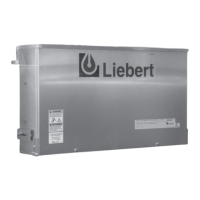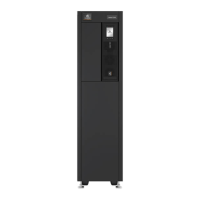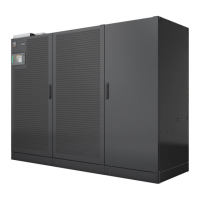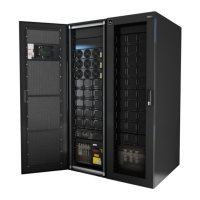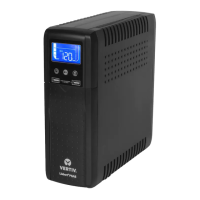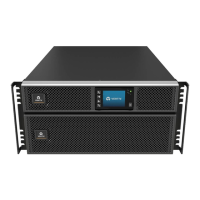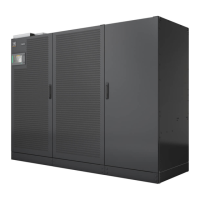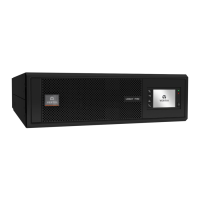Do you have a question about the Vertiv LIEBERT NXC 60KVA and is the answer not in the manual?
Safety precautions for installation and use, avoiding hazards.
Guidelines for safe operating environment and avoiding specific conditions.
Criticality of earth connection and selection of RCCB/RCD devices.
High voltage inside, IP20 standard, safety shields.
Requires tools, trained personnel, and caution with high voltage.
AC-DC-AC conversion, rectifier, inverter, battery charger.
How loads are supplied by inverter or bypass, and maintenance bypass.
Normal operation, mains abnormal, and mains recovery scenarios.
Connecting multiple UPS modules for increased capacity/reliability.
Requirements for parallel module configuration and wiring.
UPS operation using battery power during mains failure.
Programming multiple UPS modules for parallel operation.
Overview of battery management functions.
Constant current, constant voltage, and float charging methods.
Battery converter shutdown at End-of-Discharge voltage.
Battery maintenance and capacity self-test functions.
Protection features for battery low pre-warning, EOD, and BCB.
Environmental and mechanical considerations for installation.
Do not disassemble without permission; install by authorized engineer.
High voltage caution when handling batteries; wear safety glasses.
Requirements for UPS location and environment.
Cool, dry, clean-air indoor environment with adequate ventilation.
Requirements for battery installation environment and temperature.
Precautions and methods for moving the UPS cabinet.
Procedures for positioning and fixing the UPS using adjustable feet.
Procedures for connecting power cables.
Requirements for UPS input, bypass, output, and battery cables.
Importance and method of connecting protective earth.
Requirements for external protective devices for UPS input and battery.
Protection devices for input power.
Requirements for RCCB and leakage current considerations.
BCB box for external battery protection.
Protective device for UPS output.
Steps for connecting power cables.
Connecting system input for common and split bypass configurations.
Connecting system output cables to the load.
Connecting external battery to BCB and UPS.
Overview of signal cable connections and ports.
Steps for cabling and routing signal cables.
Description of operator control keys.
Settings for display, date/time, communication, and configuration.
Commands for battery tests, system tests, and charging.
Complete list of UPS alarm messages.
Important warnings and safety advice for operation.
Procedures for starting the UPS.
Steps to turn on the UPS from a powered-down state.
Steps for starting the UPS from battery power.
Procedures for changing UPS operation modes.
Transferring UPS to maintenance mode for service.
Procedures for performing battery maintenance and capacity tests.
Procedures for running UPS self-tests.
Procedures for completely powering down the UPS.
Steps for shutting down UPS and load power.
Procedures to power down UPS while keeping load powered.
Emergency Power Off procedures.
Resetting the UPS after EPO or fault conditions.
Safety precautions for working with UPS batteries.
Fresh air volume and temperature requirements for batteries.
Procedures for installing and connecting batteries.
Steps for installing batteries and checking accessories.
How to connect batteries in series and parallel, and safety warnings.
Precautions and procedures for battery maintenance.
Operating procedures for parallel UPS systems.
Steps to turn on parallel UPS modules in normal mode.
Procedures for transferring parallel systems to maintenance bypass.
Steps to isolate a UPS module from a parallel system.
Steps to reintegrate a UPS module into a parallel system.
Procedures for shutting down parallel UPS systems.
Shutting down parallel UPS while keeping load powered.
Safety precautions for UPS service and maintenance.
Specifications for the battery and charging circuit.
Specifications for the inverter output to the load.
Safety precautions for installation and use, avoiding hazards.
Guidelines for safe operating environment and avoiding specific conditions.
Criticality of earth connection and selection of RCCB/RCD devices.
High voltage inside, IP20 standard, safety shields.
Requires tools, trained personnel, and caution with high voltage.
AC-DC-AC conversion, rectifier, inverter, battery charger.
How loads are supplied by inverter or bypass, and maintenance bypass.
Normal operation, mains abnormal, and mains recovery scenarios.
Connecting multiple UPS modules for increased capacity/reliability.
Requirements for parallel module configuration and wiring.
UPS operation using battery power during mains failure.
Programming multiple UPS modules for parallel operation.
Overview of battery management functions.
Constant current, constant voltage, and float charging methods.
Battery converter shutdown at End-of-Discharge voltage.
Battery maintenance and capacity self-test functions.
Protection features for battery low pre-warning, EOD, and BCB.
Environmental and mechanical considerations for installation.
Do not disassemble without permission; install by authorized engineer.
High voltage caution when handling batteries; wear safety glasses.
Requirements for UPS location and environment.
Cool, dry, clean-air indoor environment with adequate ventilation.
Requirements for battery installation environment and temperature.
Precautions and methods for moving the UPS cabinet.
Procedures for positioning and fixing the UPS using adjustable feet.
Procedures for connecting power cables.
Requirements for UPS input, bypass, output, and battery cables.
Importance and method of connecting protective earth.
Requirements for external protective devices for UPS input and battery.
Protection devices for input power.
Requirements for RCCB and leakage current considerations.
BCB box for external battery protection.
Protective device for UPS output.
Steps for connecting power cables.
Connecting system input for common and split bypass configurations.
Connecting system output cables to the load.
Connecting external battery to BCB and UPS.
Overview of signal cable connections and ports.
Steps for cabling and routing signal cables.
Description of operator control keys.
Settings for display, date/time, communication, and configuration.
Commands for battery tests, system tests, and charging.
Complete list of UPS alarm messages.
Important warnings and safety advice for operation.
Procedures for starting the UPS.
Steps to turn on the UPS from a powered-down state.
Steps for starting the UPS from battery power.
Procedures for changing UPS operation modes.
Transferring UPS to maintenance mode for service.
Procedures for performing battery maintenance and capacity tests.
Procedures for running UPS self-tests.
Procedures for completely powering down the UPS.
Steps for shutting down UPS and load power.
Procedures to power down UPS while keeping load powered.
Emergency Power Off procedures.
Resetting the UPS after EPO or fault conditions.
Safety precautions for working with UPS batteries.
Fresh air volume and temperature requirements for batteries.
Procedures for installing and connecting batteries.
Steps for installing batteries and checking accessories.
How to connect batteries in series and parallel, and safety warnings.
Precautions and procedures for battery maintenance.
Operating procedures for parallel UPS systems.
Steps to turn on parallel UPS modules in normal mode.
Procedures for transferring parallel systems to maintenance bypass.
Steps to isolate a UPS module from a parallel system.
Steps to reintegrate a UPS module into a parallel system.
Procedures for shutting down parallel UPS systems.
Shutting down parallel UPS while keeping load powered.
Safety precautions for UPS service and maintenance.
Specifications for the battery and charging circuit.
Specifications for the inverter output to the load.
| Power Rating | 60 kVA |
|---|---|
| Active Power | 54 kW |
| Frequency | 50/60 Hz |
| Input Frequency | 40-70 Hz |
| Output Frequency | 50/60 Hz |
| Topology | Double Conversion Online |
| Operating Temperature | 0°C to 40°C |
| Input Voltage | 380/400/415V AC (3-phase) |
| Output Voltage | 380/400/415V AC (3-phase) |
| Battery Type | Valve Regulated Lead Acid (VRLA) |
| Battery Runtime | Varies based on battery configuration |
| Weight | 210 kg (without batteries) |
| Efficiency | Up to 95% |
| Communication Interface | RS232, USB |


